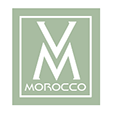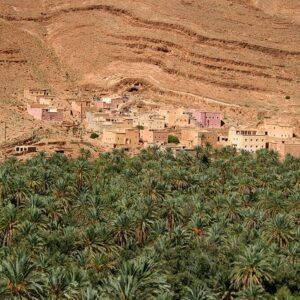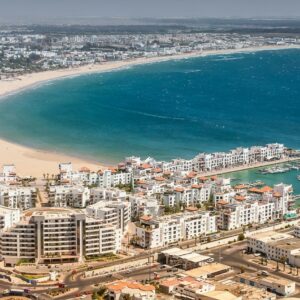Description
Day 1 Transfer to the hotel where we will spend the night.
Our hotel in Marrakesh is located in the new city outside the old walls. This area boasts wide boulevards lined with shops, restaurants, and cafes. It’s a great place to return to and relax after the sightseeing of the coming days.
Meals: Dinner (unless we arrive late at night).
Accommodation: Marrakesh
Day 2 City tour of Marrakesh
We have the whole day to explore this exotic ancient caravan city, which was the main city of the Almoravids in the 11th century. The city lies like an oasis on the edge of the desert and at the foot of the Atlas Mountains, making it an important hub for trade between the Sahara and North Africa. Back then – as now – the tall minaret of the Koutoubia Mosque rises above the city’s rooftops. We see the minaret, which is one of the city’s landmarks. We can’t enter the mosque itself, as only Muslims are allowed into mosques in Morocco. Instead, we visit the Bahia Palace, whose sumptuous buildings give an impression of the luxury that past rulers surrounded themselves with. The palace’s garden is also a great experience with its jasmine and orange blossoms.
We have lunch at a local restaurant before venturing into Marrakesh’s labyrinthine medina. Here, roads wind in all directions, and it’s easy to lose orientation among the many small shops and workshops. We stop, among other places, at a traditional Berber pharmacy, where we learn about medicinal herbs and remedies.
Most roads in the medina eventually lead to Djemaa el Fna Square, where musicians, dancers, acrobats, healers, writers, storytellers, snake charmers, and fruit vendors gather. It’s always bustling with life on the square. Especially when night falls, lanterns are lit, and the scent of grilled meat, couscous, and delicious cakes fills the evening air.
Meals: Breakfast and lunch
Accommodation: Marrakesh
Day 3 Over the mountain pass to the desert town of Ait Ben Haddou
A long but scenic drive awaits us as we leave Marrakesh and head south. The road winds over high mountain passes, offering stunning views of the Atlas Mountains. Small Berber villages cling to the mountainsides, and in the valleys, pomegranate trees, walnut trees, and poplars grow.
Our destination is the medieval city of Ait Ben Haddou, which emerges in the landscape like a pure revelation. A kasbah is a group of interconnected houses with a wall around. A building style originating from the need for defense against foreign tribes. Morocco has many kasbahs, but this is one of the oldest and perhaps the most photogenic in the entire country. It’s not surprising that Hollywood has fallen in love with the city, which has been used as a backdrop in a long list of blockbuster films. But the city is not just a backdrop. The oldest buildings can be dated back to the 11th century, and Ait Ben Haddou was for centuries a hub on the caravan routes that brought gold, salt, and slaves from the Sahara to Marrakesh.
Meals: Breakfast and lunch
Accommodation: Ait Ben Haddou
Day 4 Along caravan routes to Taroudant
It’s worth getting up early to experience the morning light over Ait Ben Haddou before we drive the short distance to the larger city of Ourzazate. That Ourzazate has also been a significant trading city on caravan routes is evident when we visit Taourirt Kasbah this morning. It’s a mighty fortress in clay and straw that belonged to the powerful Glaoua family until independence in 1956. From here, they could control trade, and they were well protected if there were attacks from outside.
From Ourzazate, we head towards Taroudant along one of the former caravan routes. The landscapes along the way are harsh in many places, giving an impression of how resilient the caravan drivers of yesteryear must have been to complete their perilous journeys. Fortunately, we can just sit back and enjoy the view of the rocky desert landscapes from the bus.
En route, we visit a small carpet factory in Taznakht, run by a women’s cooperative. Traditional carpets with beautiful patterns and colors are produced here. Some carpets can take several months to produce.
We continue to a small village known for its saffron production. Here, we learn about the entire process from the flowers to the finished valuable spice. Another exciting stop is the dramatic Kasbah Tallouine, which stands like a desert fortress in the dry landscapes. It’s no longer possible to enter the old building, but we see it from the outside before continuing towards Taroudant.
Upon arrival in Taroudant in the late afternoon, we check into our hotel for the night.
Meals: Breakfast and dinner
Accommodation: Taroudant
Day 5 Taroudant and night in a riad in Essaouira
We spend the morning in Taroudant. We stroll through the old medina, where there’s a very special atmosphere. The city was founded before the arrival of Islam, but it had its golden period in the 16th century when it was the capital of the Saadi dynasty under the name Mohamedia. From that time, there are still 8 km of city walls standing as a proud reminder of past battles. Walking through one of the five monumental city gates and into the medina is like stepping back in time. The labyrinthine alleys may seem cluttered at first, but they are actually part of a carefully laid out plan.
After lunch, we continue towards the Atlantic Ocean and the coastal town of Essaouira. On the way, we stop in the coastal town of Agadir for lunch. We arrive in Essaouira late in the afternoon, where we check into a riad. Riads are traditional Moroccan buildings converted into small hotels. They are often very charming with a courtyard in the middle and rooms around it. There will be differences in the size and decor of the rooms. But the rooms are allocated randomly, and the experience of staying in the cozy surroundings is worth it all. Even if you get one of the smaller rooms.
Meals: Breakfast and lunch
Accommodation: Essaouira
Day 6 Charming Essaouira
It’s incredibly easy to fall in love with Essaouira, beautifully situated by the Atlantic Ocean. Small fishing boats bring in the day’s catch in the city’s harbor, and in the cozy old town – which is also car-free – the streets are filled with the city’s rich history. Essaouira was once the main center for purple dye exports to the Roman Empire. Later, Essaouira was the main center for slave caravans coming from Timbuktu, laden with hides, gold, ostrich feathers, and slaves. Under Sultan Moulay Abdallah in the 18th century, the city was rebuilt. The fortress La Scala was built, the city walls expanded, and the port became the most important in the country. All this went on until the French in the 20th century decided that Casablanca should be developed, after which Essaouira was forgotten.
However, in the early 1970s, Essaouira flourished again. This time as a “paradise” for hippies, and the city was inhabited by stars like Leonard Cohen, Jefferson Airplane, and Jimi Hendrix. Today, Essaouira is known for its artist colony and its special gnawa music. We explore this lovely city together in the morning. After lunch, there is free time.
Meals: Breakfast and lunch
Accommodation: Essaouira
Day 7 Marrakesh on your own
After breakfast at the riad, we head back to Marrakesh. On the way, we stop at a women’s cooperative that produces argan oil from argan nuts. The nuts come from the argan tree; a special plant that only grows here in the area. The oil from roasted argan nuts is used for dressing, while the raw oil is an ingredient in cosmetic creams and oils. We then continue to Marrakesh, where we have lunch. The rest of the day is free to explore Marrakesh on your own before we meet again in the evening for a farewell dinner.
Meals: Breakfast, lunch, and dinner
Accommodation: Marrakesh
Day 8 Free time and departure
Free time until we drive to the airport, from where we fly back to Denmark.
On some departures, there is an early morning departure.
Meals: Breakfast





